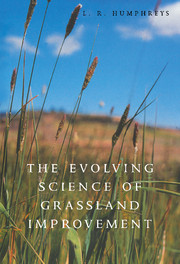Book contents
- Frontmatter
- Contents
- Preface
- Acknowledgements
- Abbreviations
- 1 Grassland improvement and environmental protection
- 2 The plant genetic base for grassland improvement
- 3 The nitrogen economy of grasslands
- 4 Growth and defoliation
- 5 Grassland ecology
- 6 Grazing management
- 7 Innovation, optimization and the realization of change
- Appendix The International Grassland Congresses
- References
- Index
3 - The nitrogen economy of grasslands
Published online by Cambridge University Press: 19 September 2009
- Frontmatter
- Contents
- Preface
- Acknowledgements
- Abbreviations
- 1 Grassland improvement and environmental protection
- 2 The plant genetic base for grassland improvement
- 3 The nitrogen economy of grasslands
- 4 Growth and defoliation
- 5 Grassland ecology
- 6 Grazing management
- 7 Innovation, optimization and the realization of change
- Appendix The International Grassland Congresses
- References
- Index
Summary
Introduction
Nitrogen availability is the primary mineral constraint to plant and animal production from grassland. The supply of other nutrients, such as phosphorus, limits plant response to N, but on a global basis N deficiency is the most significant nutrient factor which determines the level of animal output and the stability of the ecosystem. It is also a production factor which is within the power of the farm manager to modify.
Other edaphic themes occupy the grassland scientist: salinity and mineral toxicities, the balance of nutrient requirements, and the stability and structure of the soil. Nitrogen economy (Whitehead, 1995) is selected as the theme of this chapter because of the close positive relationship between growth and soil N (see for example, Graham et al., 1981), and because of the controversies which have occupied grassland scientists in the past 50 years. These have centred about the reliance on the legume for biological N fixation and alternatively on N fertilizer produced from fossil fuel, and more recently about the atmospheric and stream pollution arising from N in agricultural systems.
The Fourth International Grassland Congress
At the IV International Grassland Congress, held in Aberystwyth, Wales, in 1937, the President R.G. Stapledon affirmed: ‘No grassland is worthy of the name, and indeed is hardly worth bothering with, unless a legume is at work.
- Type
- Chapter
- Information
- The Evolving Science of Grassland Improvement , pp. 74 - 107Publisher: Cambridge University PressPrint publication year: 1997



